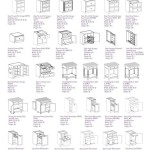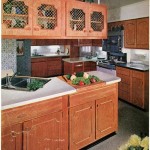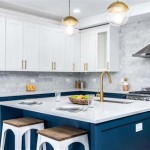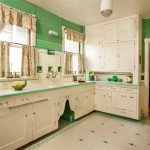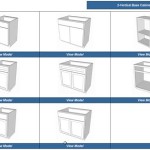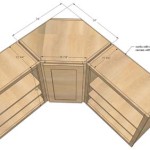The Enduring Charm of 1950 Vintage Metal Kitchen Cabinets
The mid-20th century witnessed a significant shift in kitchen design, largely influenced by advancements in manufacturing and evolving societal expectations. An iconic feature of this era was the widespread adoption of metal kitchen cabinets. These cabinets, now highly sought-after as "1950 Vintage Metal Kitchen Cabinets," represent more than just storage solutions; they embody a period of optimism, innovation, and a distinct aesthetic sensibility.
Metal kitchen cabinets of the 1950s were a departure from the traditional wooden cabinetry that had dominated kitchens for generations. The transition to metal reflected a desire for durability, ease of cleaning, and a modern, streamlined appearance. The introduction of mass production techniques made metal cabinets more accessible to a wider range of homeowners, solidifying their place in the landscape of American homes.
Beyond their functional advantages, 1950 vintage metal kitchen cabinets possess a unique visual appeal. Their distinctive color palettes, often featuring pastel hues like turquoise, pink, yellow, and mint green, evoke a sense of nostalgia and contribute to the retro charm that is so highly valued today. The rounded edges, chrome hardware, and minimalist designs further enhance their vintage aesthetic, making them a focal point in any kitchen setting.
The Rise of Metal in Kitchen Design
The popularity of metal kitchen cabinets in the 1950s was not accidental; it was the result of several converging factors. Following World War II, the United States experienced a period of rapid economic growth and technological advancement. This translated into increased consumer spending and a desire for modern, efficient appliances and home furnishings.
Metal, particularly steel, emerged as a material of choice for kitchen cabinets due to its inherent advantages. Steel is known for its strength, durability, and resistance to pests and moisture, making it a practical choice for the demanding environment of a kitchen. Unlike wood, metal cabinets were less susceptible to warping, rotting, or damage from insects.
Furthermore, the development of new manufacturing processes, such as powder coating and enamel finishing, allowed for a wide range of colors and finishes to be applied to metal cabinets. This opened up possibilities for personalization and allowed homeowners to customize their kitchens to reflect their individual tastes. The availability of vibrant colors, combined with the smooth, clean lines of the metal cabinets, contributed to the overall modern and optimistic feel of 1950s kitchens.
Companies like Youngstown Kitchens, Geneva Modern Kitchens, and St. Charles Steel Kitchens became synonymous with metal kitchen cabinets during this era. These manufacturers pioneered innovative designs and production techniques, setting the standard for the industry. Their cabinets were often featured in magazines, advertisements, and model homes, further solidifying their popularity and desirability.
The emphasis on efficiency and functionality in 1950s kitchens also played a role in the adoption of metal cabinets. The design of these cabinets often incorporated features such as built-in storage, pull-out shelves, and integrated appliances, all aimed at streamlining kitchen tasks and maximizing space. The clean lines and smooth surfaces of metal cabinets also made them easy to clean and maintain, a significant advantage for busy homemakers.
Key Features of 1950s Vintage Metal Kitchen Cabinets
Understanding the defining characteristics of 1950 vintage metal kitchen cabinets is crucial for identifying and appreciating their unique qualities. These cabinets possess a distinct set of features that set them apart from both earlier and later styles of kitchen cabinetry.
Color Palettes: The most recognizable feature of 1950s metal kitchen cabinets is their vibrant color palettes. Pastel shades were particularly popular, including turquoise, pink, yellow, mint green, and robin's egg blue. These colors reflected the optimistic and playful spirit of the era. While solid colors were common, some cabinets also featured two-tone designs, with contrasting colors used for the doors and frames.
Hardware: The hardware used on 1950s metal kitchen cabinets is another distinctive element. Chrome was the most common finish, providing a sleek and modern look. Cabinet pulls and knobs often had rounded edges and streamlined designs, reflecting the overall aesthetic of the era. Some cabinets also featured decorative details, such as embossed patterns or contrasting color accents on the hardware.
Construction and Materials: As the name suggests, metal was the primary material used in the construction of these cabinets. Steel was the most common choice, known for its strength and durability. The cabinets were typically constructed with a welded steel frame, providing a solid and stable structure. The doors and drawers were usually made of steel as well, with a baked enamel or powder-coated finish for protection and color.
Design Elements: The design of 1950s metal kitchen cabinets emphasized clean lines, simple shapes, and functionality. Cabinets often had rounded corners and edges, softening their appearance and making them more user-friendly. Many cabinets featured integrated storage solutions, such as pull-out shelves, spice racks, and bread boxes. Some models also included built-in features like cutting boards or fold-down work surfaces.
Brand Identification: As mentioned earlier, several manufacturers dominated the metal kitchen cabinet market in the 1950s. Identifying the brand of a cabinet can provide valuable information about its quality, design, and provenance. Look for manufacturer's labels or markings on the inside of the cabinets or on the hardware. Common brands to look out for include Youngstown Kitchens, Geneva Modern Kitchens, St. Charles Steel Kitchens, and All-Steel-Bilt.
Restoring and Incorporating Vintage Metal Cabinets Today
The enduring appeal of 1950 vintage metal kitchen cabinets has led to a growing interest in their restoration and incorporation into modern kitchens. Whether you are looking to preserve the original charm of a vintage kitchen or add a retro touch to a contemporary space, these cabinets offer a unique and stylish option.
Restoration Considerations: One of the primary considerations when dealing with vintage metal cabinets is their condition. Over time, the original finish may have become chipped, scratched, or faded. Rust can also be a concern, particularly in humid environments. Before attempting any restoration work, it is important to assess the extent of the damage and determine the best course of action.
Cleaning and Refinishing: Cleaning is the first step in restoring metal kitchen cabinets. Use a mild detergent and water to remove dirt, grease, and grime. For stubborn stains, you may need to use a specialized cleaner designed for metal surfaces. Once the cabinets are clean, you can assess whether refinishing is necessary. If the original finish is heavily damaged, refinishing can restore the cabinets to their former glory. This typically involves stripping the old finish, repairing any rust or damage, and applying a new coat of paint or powder coating.
Hardware Replacement: Replacing damaged or missing hardware can significantly improve the appearance of vintage metal cabinets. Look for reproduction hardware that matches the original style and finish. Many online retailers specialize in vintage or reproduction hardware, making it easier to find the perfect replacements.
Integration into Modern Kitchens: Incorporating 1950 vintage metal kitchen cabinets into a modern kitchen requires careful planning and design. One approach is to use the vintage cabinets as a focal point, pairing them with contemporary appliances and countertops to create a unique and eclectic look. Another approach is to blend the vintage cabinets seamlessly into the overall design, complementing their retro charm with modern elements that enhance their aesthetic appeal.
Color Coordination: Color coordination is crucial when integrating vintage metal cabinets into a modern kitchen. Choose colors that complement the original pastel hues of the cabinets, creating a cohesive and balanced look. White, gray, and other neutral colors can provide a subtle backdrop that allows the vintage cabinets to stand out. Alternatively, you can use bolder colors to create a more dramatic and eye-catching effect.
Modern Appliances: Modern appliances can be seamlessly integrated into a kitchen featuring vintage metal cabinets. Stainless steel appliances provide a sleek and contemporary contrast to the retro charm of the cabinets. Alternatively, you can opt for appliances with a retro-inspired design, such as refrigerators and stoves with rounded edges and vintage-inspired color options.
In conclusion, 1950 vintage metal kitchen cabinets represent a significant chapter in the history of kitchen design. Their durability, functionality, and distinctive aesthetic qualities have made them a highly sought-after item among collectors and homeowners alike. By understanding their history, features, and restoration techniques, one can appreciate the enduring charm of these iconic pieces of mid-century design and successfully incorporate them into modern living spaces.

The History Of Vintage Steel Kitchen Cabinets 100 Brands Retro Renovation

This Time Capsule Ge Steel Kitchen Has Almost Everything Kitchens Were Famous For Retro Renovation

Update Montgomery Ward Steel Kitchen Cabinets A Catalog From 1941 Retro Renovation Metal Vintage Decor

Vintage Metal Cabinets Sweden

Vintage Steel Kitchen Cabinetry Old Houses Under 50k

Morton Steel Kitchen Cabinets Since 1942 Retro Renovation

Aqua Ge Metal Kitchen Cabinets For On The Forum Michigan Retro Renovation Vintage

Vintage Metal Kitchen Cabinets Includes Full Length Coat Cabinet Not Pictured

Morton Vintage Metal Steel Kitchen Cabinets 1950s Mid Century For

How Can I Change Up Old Metal Kitchen Cabinets Besides Painting Them Hometalk

